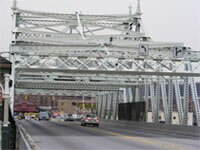
University Heights Bridge 
University Heights Bridge Fast Facts
- William H. Burr, with
- Alfred P. Boller and
- George W. Birdsall
History

The University Heights Bridge is a two-lane swing bridge that carries automobile and pedestrian traffic over the Harlem River between 207th Street in Manhattan and Fordham Road in The Bronx. It not only replaced an older bridge near the site, but was originally erected and used in another place and relocated to its current site, and, decades later, was reconstructed.
Through most of the nineteenth century, there was little or no traffic on the Harlem River north of Morris Dock (today, Roberto Clemente State Park) because of shallow water. Thus, the first crossing in the area was a 32-foot wide wooden footbridge with a draw of only 3.9 feet above mean low water just north of the current bridge. It was built in 1881 by the Department of Public Parks and paid for by certain residents of the Inwood section of Manhattan.
In 1891, the Army Corps of Engineers began dredging the river north of this bridge, which was removed soon afterward. The dredging plan included cutting Marble Hill off Manhattan Island by digging the Harlem River Ship Canal. To carry Broadway traffic over the canal, a steel swing bridge was built in 1895.
Meanwhile, mainlanders increasingly demanded a new bridge be built across the Harlem River near the old footbridge. Bronx Alderman William D. Peck campaigned for it. Plans for its location and design were considered by various city authorities from 1901 to 1903. The city's Board of Alderman passed a law in 1903 providing for the new crossing that also abolished the grade crossing at the railroad tracks along the Bronx shoreline and gave access to the waterfront via a ramp from the north side of the Bronx approach. Land for the Bronx approaches was acquired, while 207th Street in Manhattan east of Ninth Avenue was widened ten feet.

On May 17, 1904, the Board of Alderman named the span the University Heights Bridge. This was probably done at the urging of Henry Mitchell MacCracken, Chancellor of New York University, who established a Bronx campus in 1894 and worked diligently to fix the name University Heights on the surrounding neighborhood. That campus is now used by Bronx Community College.
In the summer of 1903, the Board of Estimate and the Board of Aldermen approved plans for the bridge. A 2,200-foot long, 13-foot deep dredged channel west of the center pier and near the draw span was approved by the Secretary of War. On November 18, 1903, the Foundation and Contracting Company began this work that included sinking a caisson, building a center pier on it and constructing a pile fender for the draw span. On April 27, 1905, the Snare and Triest Company began to build the bridge and its approaches.
Meanwhile, the extension of the city's original subway line under Broadway north of 145th Street in Manhattan was being constructed. It was built as an elevated structure north of Dyckman Street destined to terminate at 242nd Street and Van Cortlandt Park in The Bronx. Unfortunately, the 1895 bridge over the Harlem River Ship Canal could not permit an elevated line to pass through its superstructure. Thus, plans for the University Heights Bridge incorporated the still perfectly good Broadway Bridge.
John B. McDonald took control of the Broadway Bridge under contract with the Rapid Transit Subway Commission. On June 14, 1906, he lifted the draw span from its pier, floated it downriver on a barge and deposited it on the new center pier of the University Heights Bridge.
The University Heights Bridge was opened to traffic on January 8, 1908 before it was completed. In July, the Spiro Company started to lay cables and equip the bridge for electrical operations. While the boiler was retained from the old Broadway Bridge, an e1ectric motor replaced the steam engine.

In 1905, the Union Railway Company received permission to operate trolley cars across the bridge. Rails were laid in 1910 and much of the original pavement was replaced with durable wooden blocks. The buckle plates that formed the bridge's deck were taken up and replaced. Trolleys began their run across the bridge on November 29, 1910. Trolleys were replaced by bus service after World War II.
In 1911, Thomas O'Connor received the contract to build the timber roadway north of the Bronx approach to the bridge leading to the waterfront below that was part of the original plan. The design of the bridge's structure attracted much public admiration, and, in 1984, the New York City Landmarks Preservation Commission declared the University Heights Bridge an official city landmark.
Nevertheless, increasing traffic over the aging bridge with wider and heavier automobiles and trucks led the city's Department of Transportation to reconstruct the University Heights Bridge. From 1989 to 1990, at the cost of $25,000,000, a new swing span was barged in and put in place, new electrical and mechanical systems were installed, and the two lanes on the bridge were widened. Because of its landmark status, great care was taken to make the replaced elements look like the original ones.

